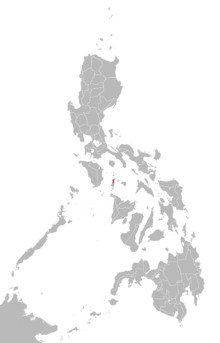Bantoanon language
| Bantoanon[1] | |
|---|---|
| Native to | Philippines |
| Region | Romblon |
Native speakers | 75,000 (2011)[3] |
| Language codes | |
| ISO 639-3 |
bno |
| Glottolog |
bant1288[5] |
 Bantoanon language map based on Ethnologue | |
The Bantoanon language[6][7] (Asi language) is a regional Visayan language spoken, along with Romblomanon and Onhan, in the province of Romblon, Philippines. Asi originated in the island of Banton, Romblon and spread to the neighboring islands of Sibale, Simara, and the towns of Odiongan and Calatrava on Tablas Island. The Asi spoken in Odiongan is called Odionganon, Calatravanhon in Calatrava, Sibalenhon in Concepcion, Simaranhon in Corcuera, and Bantoanon in Banton.
Specifically, it is spoken on the following islands within Romblon:
- Tablas: the municipalities of Odiongan and Calatrava, situated respectively on the western and northern parts of the island. The Odiongan dialect has more outside influences and is more widely used in literature.[8]
- Banton: the island's sole municipality of Banton.
- Simara: the island's sole municipality of Corcuera.
- Maestre de Campo (also known as Sibale): the island's sole municipality of Concepcion.
Linguist David Zorc notes that Bantoanon speakers may have been the first Visayan speakers in the Romblon region. He also suggests that Asi may have a Cebuan substratum and that many of its words may have been influenced by the later influx of other languages such as Romblomanon.[9]
Sounds
Bantoanon has fifteen consonant phonemes: p, t, k, b, d, g, m, n, ng, s, h, w, l, r and y. There are three vowel phonemes: a, i/e, and u/o. The vowels i and e are allophones, with i always being used when it is the beginning and sometimes end of a syllable, and e always used when it ends a syllable. The vowels u and o are allophones, with u always being used when it is the beginning and sometimes end of a syllable, and o always used when it ends a syllable. This is one of the Philippine languages that do not exhibit [ɾ]-[d] allophony.
Grammar
Pronouns
| Absolutive | Ergative | Oblique | |
|---|---|---|---|
| 1st person singular | akó | nako, ko | akò |
| 2nd person singular | ikaw, ka | nimo, mo | imo |
| 3rd person singular | sida | nida | ida |
| 1st person plural inclusive | kita | nato | ato |
| 1st person plural exclusive | kami | namo | amo |
| 2nd person plural | kamo | ninro | inro |
| 3rd person plural | sinra | ninra | inra |
References
- ↑ , more text.
- ↑ , more text.
- ↑ Bantoanon[2] at Ethnologue (18th ed., 2015)
- ↑ , more text.
- ↑ Hammarström, Harald; Forkel, Robert; Haspelmath, Martin, eds. (2017). "Asi". Glottolog 3.0. Jena, Germany: Max Planck Institute for the Science of Human History.
- ↑ https://iso639-3.sil.org/code_tables/download_tables#639-3%20Code%20Set
- ↑ , Languages of the World.
- ↑ http://www.sil.org/asia/philippines/sipl/SIPL_6-2_001-093.pdf
- ↑ Zorc, David Paul. The Bisayan Dialects of the Philippines: Subgrouping and Reconstruction. Canberra, Australia: Dept. of Linguistics, Research School of Pacific Studies, Australian National University, 1977.
- Lobel, Jason William. 2002. "An introduction to the languages of Romblon." In Sarokan News Magazine, July 8, 2002.
External links